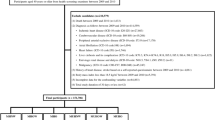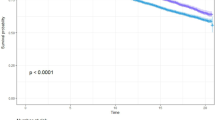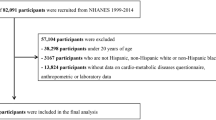Abstract
Objectives:
To study total mortality in different categories of BMI values, with adjustments for important covariates in a population-based 26-year mortality follow-up. Special interest will be given to gender differences and low BMI values.
Methods:
From a stratified sample in 1969 of 32 185 individuals aged 18–64 years from Stockholm County, 2422 underwent a health examination, with complete data obtained for 1020 subjects. BMI was classified as underweight (<20), normal (20–24.9), overweight (25–29.9) or obesity (⩾30). Participants were followed up in the National Cause of Death Register until the end of 1996. Multivariate analysis was performed by Cox regression for men and women separately, with different models, with step-wise adjustment for age, care need category, heart rate, hypertension, blood glucose, alcohol intake and smoking, with hazard ratios (HR) and 95% confidence interval (CI) and with normal weight as reference.
Results:
Among men, the age-adjusted HR was 1.68 (95% CI 1.10–2.57) for underweight and 1.62 (95% CI 1.08–2.43) for obesity, and among women it was 0.93 (95% CI 0.58–1.51) for underweight and 1.88 (95% CI 1.26–2.82) for obesity. In men, the significantly increased mortality remained when also adjusting for care need category, but not when adjusting for other factors, whereas the opposite was found regarding obesity. For women, underweight was significantly associated with decreased mortality when adjusting for smoking and for all factors together, whereas obesity was associated with increased mortality when adjusting for the different factors except for all factors together.
Conclusions:
Underweight was associated with higher mortality among men, but not when adjusting for covariates, whereas underweight was associated with lower mortality among women when adjusting for smoking.
This is a preview of subscription content, access via your institution
Access options
Subscribe to this journal
Receive 12 print issues and online access
$259.00 per year
only $21.58 per issue
Buy this article
- Purchase on Springer Link
- Instant access to full article PDF
Prices may be subject to local taxes which are calculated during checkout
Similar content being viewed by others
References
Pischon T, Boeing H, Hoffmann K, Bergmann M, Schulze MB, Overvad K et al. General and abdominal adiposity and risk of death in Europe. N Engl J Med 2008; 359: 2105–2120.
Gaesser GA . Thinness and weight loss: beneficial or detrimental to longevity? Med Sci Sports Exerc 1999; 31: 1118–1128.
Allison DB, Zhu SK, Plankey M, Faith MS, Heo M . Differential associations of body mass index and adiposity with all-cause mortality among men in the first and second National Health and Nutrition Examination Surveys (NHANES I and NHANES II) follow-up studies. Int J Obes Relat Metab Disord 2002; 26: 410–416.
Zhu S, Heo M, Plankey M, Faith MS, Allison DB . Associations of body mass index and anthropometric indicators of fat mass and fat free mass with all-cause mortality among women in the first and second National Health and Nutrition Examination Surveys follow-up studies. Ann Epidemiol 2003; 13: 286–293.
Jee SH, Sull JW, Park J, Lee SY, Ohrr H, Guallar E et al. Body-mass index and mortality in Korean men and women. N Engl J Med 2006; 355: 779–787.
Anuurad E, Shiwaku K, Nogi A, Kitajima K, Enkhmaa B, Shimono K et al. The new BMI criteria for Asians by the Regional Office for the Western Pacific Region of WHO are suitable for screening of overweight to prevent metabolic syndrome in elder Japanese workers. J Occup Health 2003; 45: 335–343.
Nyholm M, Merlo J, Rastam L, Lindblad U . Overweight and all-cause mortality in a Swedish rural population: Skaraborg Hypertension and Diabetes Project. Scand J Public Health 2005; 33: 478–486.
Flegal KM, Graubard BI, Williamson DF, Gail MH . Cause-specific excess deaths associated with underweight, overweight, and obesity. JAMA 2007; 298: 2028–2037.
Allison DB, Faith MS, Heo M, Townsend-Butterworth D, Williamson DF . Meta-analysis of the effect of excluding early deaths on the estimated relationship between body mass index and mortality. Obes Res 1999; 7: 342–354.
Baumgartner RN, Heymsfield SB, Roche AF . Human body composition and the epidemiology of chronic disease. Obes Res 1995; 3: 73–95.
Bigaard J, Frederiksen K, Tjonneland A, Thomsen BL, Overvad K, Heitmann BL et al. Body fat and fat-free mass and all-cause mortality. Obes Res 2004; 12: 1042–1049.
Wandell PE, Theobald H . The association between blood glucose value and long-term mortality. Diabetes Metab 2005; 31: 588–594.
Wandell PE, Theobald H . The association between low fasting glucose value and mortality. Curr Diabetes Rev 2007; 3: 274–279.
WHO Study Group. Diabetes Mellitus. WHO: Geneva, 1985.
Theobald H, Wandell PE . Effect of heart rate among men and women on long-term mortality. Acta Cardiologica 2007; 62: 271–275.
Theobald H, Bygren LO, Carstensen J, Engfeldt P . Validity of two questions on alcohol use in a health survey questionnaire. Scand J Public Health 1999; 27: 73–77.
Cox DR . Regression models and life-tables. J R Stat Soc 1972; 34: 187–220.
Nordberg L . Generalized linear modelling of sample survey data. J Off Stat 1989; 3: 223–239.
Gregg EW, Cheng YJ, Cadwell BL, Imperatore G, Williams DE, Flegal KM et al. Secular trends in cardiovascular disease risk factors according to body mass index in US adults. JAMA 2005; 293: 1868–1874.
Unal B, Critchley JA, Capewell S . Explaining the decline in coronary heart disease mortality in England and Wales between 1981 and 2000. Circulation 2004; 109: 1101–1107.
Berg C, Rosengren A, Aires N, Lappas G, Toren K, Thelle D et al. Trends in overweight and obesity from 1985 to 2002 in Goteborg, West Sweden. Int J Obes (London) 2005; 29: 916–924.
Carlsson AC, Wandell PE, de Faire U, Hellenius ML . Risk factors associated with newly diagnosed high blood pressure in men and women. Am J Hypertens 2008; 21: 771–777.
Wandell PE, de Faire U, Hellenius ML . High intake of alcohol is associated with newly diagnosed diabetes in 60-year-old men and women. Nutr Metab Cardiovasc Dis 2007; 17: 598–608.
Acknowledgements
This study was supported by grants from Stockholm County Council.
Author information
Authors and Affiliations
Corresponding author
Rights and permissions
About this article
Cite this article
Wändell, P., Carlsson, A. & Theobald, H. The association between BMI value and long-term mortality. Int J Obes 33, 577–582 (2009). https://doi.org/10.1038/ijo.2009.36
Received:
Revised:
Accepted:
Published:
Issue Date:
DOI: https://doi.org/10.1038/ijo.2009.36
Keywords
This article is cited by
-
Combined lifestyle factors on mortality among the elder population: evidence from a Chinese cohort study
BMC Geriatrics (2022)
-
Sex-specific associations between adolescent categories of BMI with cardiovascular and non-cardiovascular mortality in midlife
Cardiovascular Diabetology (2018)
-
The impact of low body mass index on postoperative outcomes in pancreatectomy patients: a retrospective analysis of Japanese administrative data
Journal of Anesthesia (2018)
-
Risk factor analysis for re-collapse of cemented vertebrae after percutaneous vertebroplasty (PVP) or percutaneous kyphoplasty (PKP)
International Orthopaedics (2018)
-
Association of anthropometric measures with kidney disease progression and mortality: a retrospective cohort study of pre-dialysis chronic kidney disease patients referred to a specialist renal service
BMC Nephrology (2016)



